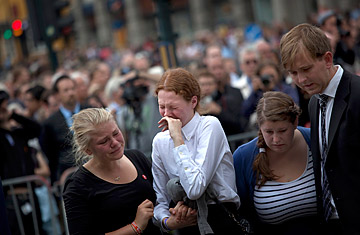
People react at the end of a memorial service at Oslo Cathedral on Sunday, July 24, 2011, in the aftermath of the Friday attacks on Norway's government headquarters and a youth retreat in Oslo
In 2005, Norway's populist, far-right Progress Party ran election-campaign posters that featured a dark-skinned man pointing a gun at the camera and the slogan "The perpetrator is of foreign origin." Today, these posters carry a terrible irony: Anders Behring Breivik — a tall, blond, blue-eyed farmer not of foreign origin — massacred dozens of Norwegian schoolchildren on Friday, July 22, in what seems to have been a deranged attempt to spark a revolution against the influx of foreigners he felt was diluting Norway's heritage.
It is dangerous to look for answers in the mind of a madman. It does not necessarily reveal anything useful about a nation if one of its citizens murders under the banner of a particular ideology. But if Breivik's psychopathy is unique, in Norway and other Nordic countries his political beliefs are surprisingly widespread. It may seem shocking, but Scandinavia — for years a model of tolerance and cooperation and the sponsor of dozens of worthy international conferences and treaties — has become the latest European haven for xenophobic populist thought.
Norway's Progress Party, of which Breivik is a former member, won more than one-fifth of the national vote in the latest parliamentary election, in 2009. Last year, the Swedish Democrats became the first far-right party to enter the Swedish parliament when it captured nearly 6% of the vote despite a furor that erupted when local candidate Marie-Louise Enderleit posted a comment on Facebook that migrants should be shot in the head, put in a bag and sent back to their home countries. Denmark's Folkparty, which recently ran an anti-immigrant campaign under the slogan "Give us Denmark back," secured 14% of the vote in a 2007 election and has since been an influential coalition partner in government. And the True Finns became the third largest party represented in the Finnish Parliament after winning 19% of the vote in elections in April.
"It is the end of an era," Anders Wildfeldt, lecturer in Nordic politics at the University of Aberdeen, says of the entrance of the far right into the Nordic political mainstream. Citing the success of xenophobic parties in other parts of Europe, Wildfeldt adds, "It's becoming increasingly inaccurate to discuss Scandinavian exceptionalism."
Of course, Scandinavia was never immune to extremism, and like other parts of Europe, it has suffered at the hands of Muslim fundamentalists. Last winter, a Swedish Muslim blew himself up in a failed suicide-bombing mission in central Stockholm, and violent protests over the publication of cartoons depicting the Prophet Muhammad in a Danish newspaper in 2005 led to dozens of deaths around the world. But recently in Scandinavia, it is the far right that has proved the most dangerous of the radicalist movements. Last fall, following the Swedish elections, a gunman shot at least 15 residents of the city of Malmö, targeting people with dark skin. Bejzat Becirov, 72, the founder and leader of a mosque in Malmö, recently told TIME that the mosque has survived 300 hate attacks, including firebombings — and he blames popular stereotypes of Muslims. When he first issued the call to the faithful 30 years ago, he says, "an imam was associated with a rich sheik. But now they are widely associated with terrorists." In Norway, Breivik did not target immigrants, but a 1,500-page manifesto attributed to him by the Norwegian media made clear that his actions were motivated by anti-immigrant sentiment.
How did such a shift in the perception of Muslims happen? A common theory to explain the rise of far-right politicians throughout Europe is that they gain support during recessions because they offer a facile scapegoat — immigrants — for job losses and hardship. But in Scandinavia, the data dispute this assumption. Denmark's Folkparty and Norway's Progress Party rose to power during the boom years of the mid-2000s, when unemployment hovered around only 5% in both countries. And while Sweden has not escaped the effects of the recession, it has fared comparatively well; in 2010 its GDP grew 4%, more than any other Western OECD-member country. Yet this was the period during which the far-right Swedish Democrats broke through.
A more important political explanation, Wildfeldt and other academics say, is the convergence of major parties around a centrist political agenda, which opens a gap for extreme parties on both the left and the right. Take Sweden's recently elected Prime Minister, Fredrik Reinfeldt, for example. He's a conservative — he spent his first term privatizing companies and working to get Swedes off sick-leave and early-retirement schemes. But he also has vowed to preserve the sacred cows of the Swedish left: the country's welfare state and high tax burden. With little to distinguish Reinfeldt's "right-wing" Moderates and the "left-wing" Social Democrats, Wildfeldt says, voters have nowhere to place protest votes other than with extreme parties.
